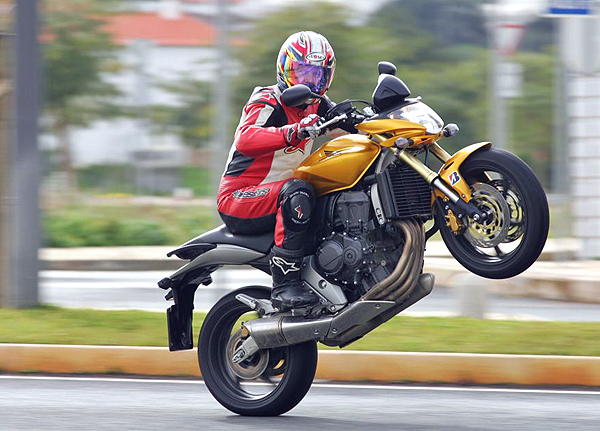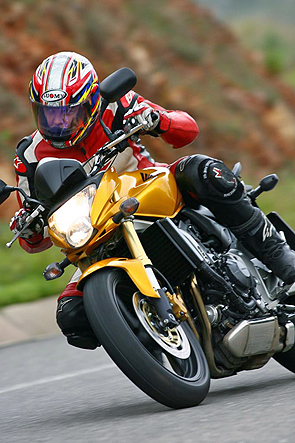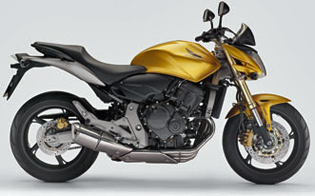
Tor has just returned from the Honda Hornet 600 press intro. before you read his report, take a look at our announcement of this European model on October 10, 2006
The Hornet has been around for a few years now, the inaugural model featuring a 16-inch front wheel and using the previous-gen CBR600F motor. For 2007, Honda has launched a brand new CB600F Hornet with the latest CBR600RR engine. Never mind the engine, though; it’s the chassis and handling that really impress.
Swinging my leg over the Hornet, I immediately settle into a comfortable position, with the 800mm (31.5 inch) seat height and relaxed ergonomics inviting me to go for a ride. The seat is comfortable and I have enough room for my legs despite this being a small motorcycle. The widened fuel tank now takes 19 litres of fuel, and I get a good grip with my knees on the edges. The fuel tank is the most obvious reminder this is the Hornet model. It stays true to the original shape, but with two extra litres of fuel capacity added. Despite the extra fuel, the CB600F feels quite light when you pick it up off the side stand or move it side-to-side while stopped.
The most obvious change from previous models is the striking new exhaust layout – the 4-into- exhaust system terminating in a fashionably stubby, MotoGP-inspired, under-peg muffler. Not exactly ground-breaking anymore, but we still think it looks good, and it’s certainly more functional than the previously fashionable under-seat mufflers. We are still a bit surprised Honda did not use this mass-centralized solution on the top dog RR as well.
Riders planning to use their Hornet for touring duties will appreciate the new exhaust layout for more than just fashion – the loss of the high-mount silencer that was found on the ’06 model opens up far greater versatility as far as mounting aftermarket luggage. The old silencer prevented the use of decent saddlebags and the new stubby exhaust now allows for all sorts of luggage solutions. Hidden to the left of the stubby exhaust underneath the engine is a huge catalytic converter that makes sure the new Hornet breezes through Euro 3 emissions standards and whatever comes next from Brussels. Whether you like the new stubby exhaust trend or not, it makes the Hornet stand out from the naked 600 crowd, and that’s not always the case with new Hondas.

The small 599cc in-line four engine wakes to life in an unintimidating manner. We shall not forget that it comes directly from the new 2007 CBR600RR supersports, but with different cams and intake valves for a broader range of power. The new engine is a full 5 kilos (11 lbs.) lighter than the one it replaces. The nature of these engines can not be changed easily to suit a naked all-round sportsbike such as the Hornet, but Honda has done their best and the engine is useful enough in the lower rpm range.
There’s very little happening when accelerating with full throttle in sixth gear from low rpm. However, what could I expect? It’s a small engine with four tiny cylinders in a row and not a big twin. So revs are still needed, but perhaps less so than on the ’06 model. The fuel injection is a gem and only once when transitioning off-on throttle around 3000rpm did I notice a very small hiccup. It was so small that I shouldn’t really have even mentioned it. For comparison, the fueling is a mile better than Suzuki’s otherwise brilliant GSR600.
The 07 Hornet features class leading horsepower too, beating both the GSR, and the Yamaha FZ6. Indeed, it is and only four horsepower short of the new Kawasaki Z750 (106ps) with the claimed 102 horsepower engine. But all that power is found in 10K+ territory, which has a lot to do with the sporty character of the new Hornet. The six-speed gearbox is as smooth as could be expected and the ratios suit both sports riding and short shifting.
Through the twisties, the new CB600F Hornet is a dream to ride. The wide handlebars make turn-in effortless, and the Hornet seems as eager as any sport bike to carve on the edges of its Bridgestone BT-012 tires. I can almost describe the handling as creamy smooth, but sharp at the same time – if that makes any sense! The Hornet always steers where I want it to go, and the line can be changed mid-corner without a hassle.
As far as chassis construction, the new aluminum mono-backbone frame and aluminum swingarm keep everything in place on a hot lap, and also contributes to keeping the weight down. Even the five-spoke aluminum wheels are new and designed to further reduce weight. At 173kg dry (380 lbs.) the new Hornet is the lightest in its class. Mass centralization was a design goal, and along with the stubby exhaust, the new slim seat and tail unit is said to contribute to mass centralization.

The inverted 41mm fork from Showa gives plenty of feedback from the front despite its lack of adjustable damping. The setup is neither too soft nor too hard, and suited to both slow uneven roads and high-speed freeway riding equally well. The rear shock is also from Showa and features a 7-step adjustable preload collar. The brakes chosen for the new Hornet are very conventional looking in today’s world of radial-mounted race-spec items, but the 2-piston front calipers provide more than enough power and feel for the job at hand. I particularly liked the way they felt during slow stop-and-go scenarios, such as around-town riding. The Hornet is also available in an ABS version that adds linked 3-piston calipers (and 4kg of weight).
We did have rain for about half the day on the launch in Portugal. From previous experience I expected excellent wet grip from the Bridgestone BT-012s, and the Hornet was no exception. I know how to use the brakes in the wet too, but in panicky situations, let’s say if an angry dog runs into your path, the ABS brakes definitely make sense. Honda is aiming the new Hornet at people looking for their first motorcycle, and with that in mind the ABS option might be a good investment. However, as an experienced rider I would personally not have gone for ABS on the Hornet, as I feel I might lose the excellent feedback offered by the standard items.
On the motorway the wind blast soon gets noticeable. The small front cowling gives scant protection. The seating position is very upright, and to crouch forward for any length of time does not feel natural for either the riding or my back. But the new Hornet has got some serious top end speed for a 600 naked, and it was fun to use some of that ability. I wouldn’t be happy touring at high speed all day long though! The new instrument panel features a large analogue rev counter with a big digital display showing speed, clock, coolant temperature and fuel consumption. To the far left is the trip counter.
Honda has modeled the design of the front cowling and headlight on a medieval knight’s helmet. I personally see similarities with the old Cagiva V-Raptor too. It was never dark enough to properly test the new headlight, but the new convex, dual-bulb design features low beam positioned above high beam.

Conclusion
Once again Honda has got it right straight away – new engine, new aluminum frame, new lightweight wheels and contemporary styling. The 07 Honda CB600F Hornet has got all that you need to tackle urban areas with ease and enough top end power to do track days and motorways. The midrange is stronger than before, as well, and might just beat most of the competition on the street. Of course, the high-revving, inline-four can’t beat a twin for midrange punch, but Honda has done everything in their power to make the midrange as punchy as possible, and for a small in-line four the result is good. The ’07 Honda Hornet is not only a safe bet, it might just be this year’s big winner.
+
Weight reduction and mass centralized handling
Brakes provide good feel
New lightweight and powerful engine
New 19 litre fuel tank (up by 2 litres)
–
You have to use the gear box for motorway overtaking.





